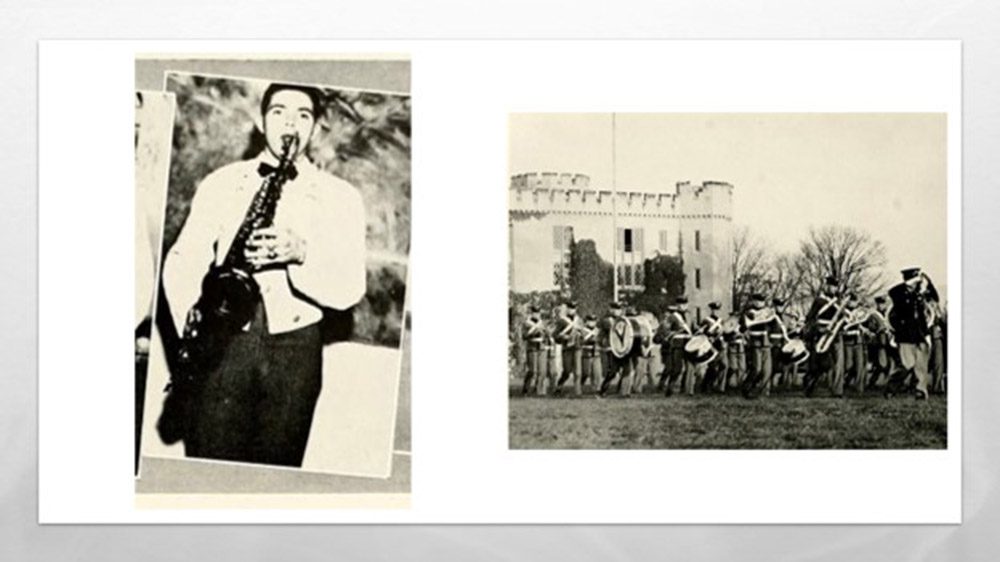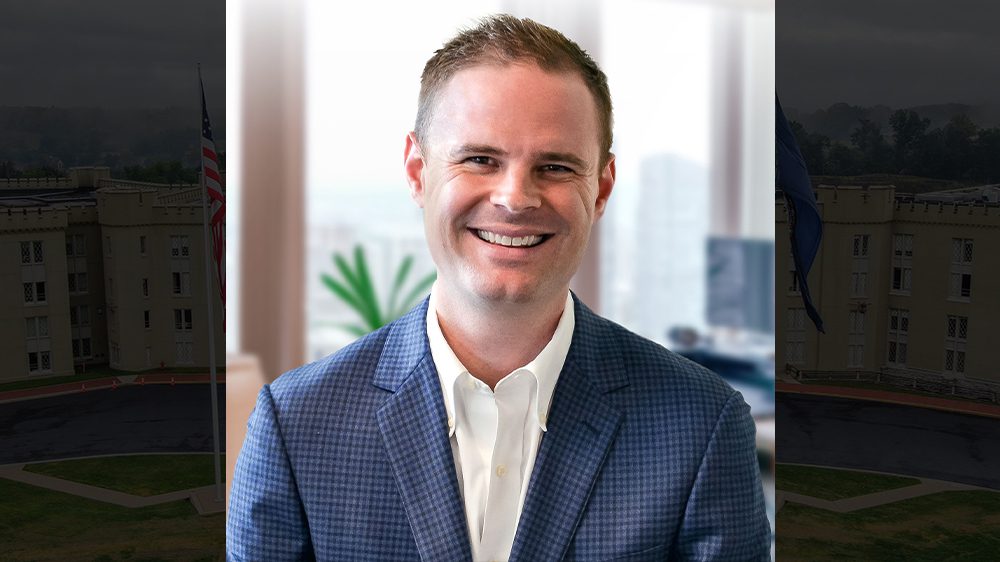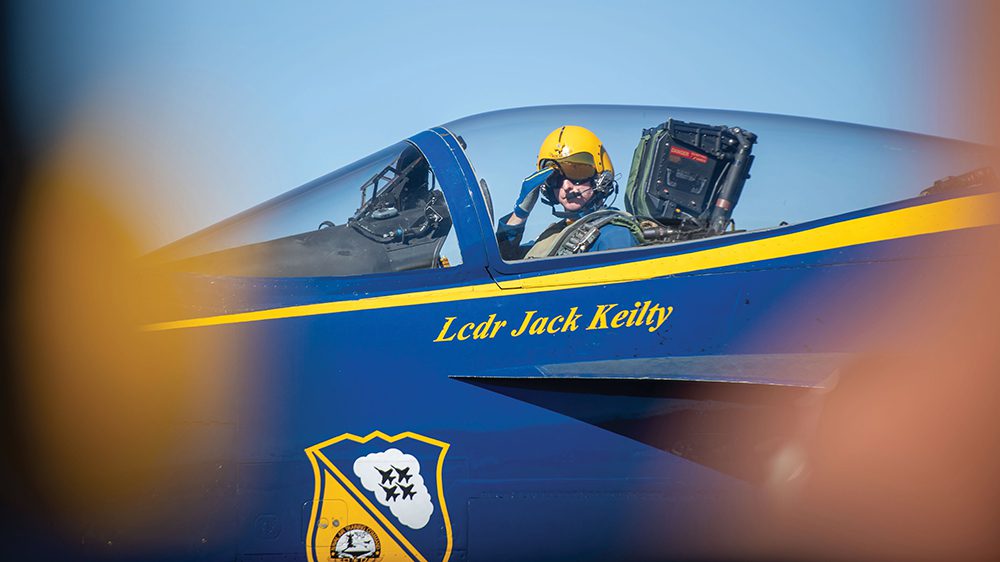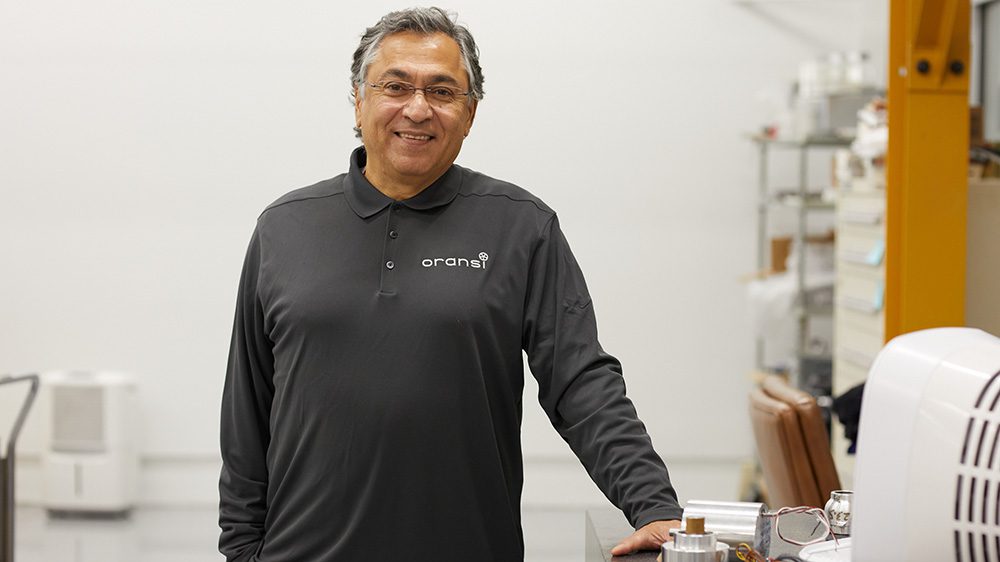On Oct. 28, 1967, 38-year-old Thomas H. Kirk Jr. ’50B left Takhli Air Base in Thailand flying an F-105 Thunderchief aircraft. He was heading for Hanoi, the most heavily defended city in the world. Kirk led 48 bombers, plus supporting aircraft, in the largest air attack on Hanoi during the Vietnam War. His target: The Paul Doumer Bridge (now called Long Bien Bridge). A seasoned pilot, Kirk had flown 50 missions in the Korean War. In Vietnam, the heavy flak, enemy fighters, and Russian-made surface-to-air missiles were, in his words, “terrifying.” The mission was his 67th.
Over the target at 14,000 feet, he called, “Roll-in,” and all planes dove for the bridge. Approximately halfway down on his dive bomb run, he felt an explosion in the rear of his aircraft. His fire warning light was on, but he stayed on task and dropped two 3,000-pound bombs on target. The bombs knocked down the bridge’s span—but Kirk’s aircraft was damaged severely, and he was losing his hydraulics. He needed to get to the jungle 40 miles south of Hanoi to be rescued by helicopter. He made it to around 27 miles.
Raising his armrests, he pulled the ejection trigger. The 600 knots per hour ejection knocked him out and yanked off his helmet. When he came to, he was blind from the wind blast and had a massive head cut. He wanted to die by suicide, so he pulled out his weapon but lost consciousness again. When he regained consciousness the second time, Vietnamese villagers were beating him. Another five minutes of this, he thought, and he would be dead—but North Vietnamese soldiers showed up, and the beating stopped. At about this time, his sight returned. The soldiers bound, gagged, and blindfolded him. They tossed him into a metal truck and took him to the Hoa Lo Prison—also called the Hanoi Hilton.
Kirk was placed in a small room, bound and blindfolded, where he was kept for two to three days (he’s not sure which) without food—just water. The first night, he was carried to a small medical space where a French-trained doctor known as “the Cat” looked him over and commented, “You are badly injured and will probably die.” After his captors moved him to a cell, he noted that from his knees to his waist, his body was burgundy from tumbling during the ejection. He could not walk for the next two months.
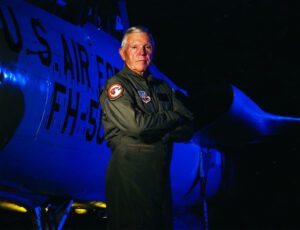
Retired U.S. Air Force Col. Thomas H. Kirk Jr. ’50B flew in both the Korean and Vietnam Wars. During his 67th mission, targeting the Paul Doumer Bridge in Hanoi, his aircraft was damaged. He was captured by North Vietnamese forces, and spent the next 5-and-a-half years as a prisoner of war.—Photos courtesy Jim Dittrich ’76, Alumni Association historian.
Next, he was taken to the interrogation room, where two North Vietnamese officers waited. The first stated, “Kirk, you are not a prisoner of war. You are a war criminal and will be tried and shot. What is your unit, and what tactics did you use?”
Kirk followed the U.S. military’s Code of Conduct and gave only his name, rank, and serial number. After refusing to answer any further questions, the senior North Vietnamese officer said, “Kirk, you are very stupid, and it will be difficult for you here.” At that point, the officers turned him over to an expert torturer. Under his direction, Kirk was tied up and brutally tortured for three days. The third day, in intense pain, he broke down and confessed, but he had no idea what he said to his captors. Everyone reached a breaking point under torture, and Kirk was not ashamed; he did his best. After the war, the Code of Conduct wording was changed. It now reads, “I will evade answering further questions to the utmost of my ability.”
Kirk’s worst period came after his captors placed him in a cell by himself. He had zero contact with any other prisoner. After a few weeks, he became so discouraged he again thought of suicide; he had never felt so low. Kirk prayed to God to help him. After his prayers, he felt at peace and like he could handle whatever the enemy threw at him. Soon, he was placed in a cell with three other prisoners for 14 months. His companionship ended when a guard hit him in the head with a heavy set of keys. This was incredibly painful, and he punched the guard, leading to 10 days of severe torture while he sat on a stool and two solitary years in a cell by himself.
In total, Kirk spent five-and-a-half years as a POW with two years in solitary confinement. How did he occupy his mind while totally alone?
He walked 4 miles a day in his 8-foot-long cell and did physical exercises as much as his starved body would allow (POWs survived on 600-800 calories a day and were always hungry). Kirk was 175 pounds when he was captured; his weight dropped to 90 pounds while a POW. He said he pretended to play the flute, doing scales and fingering for hours. He also recalled “books, stories, and even poetry” from his youth. He calculated things like mortgages in his head. Finally, he thought about faith and spiritual things, making plans for the future and how he would live his life. Then, there was the tap code. He tapped on the wall using a 25-letter alphabet and communicated with men in adjacent cells. They passed news from new POW arrivals to guidance from the senior officers. Prisoners caught tapping were tortured, but Kirk was never caught.
The Hanoi experience gave him many close friends, especially Bill Lawrence (later a vice admiral and superintendent of the U.S. Naval Academy). He also became close to John McCain (senator and presidential candidate). In 1973, Kirk was released and visited VMI soon after. He was driven around the Parade Ground and spoke to the Corps. He was a colonel and one of the country’s most decorated, with an Air Force Cross (second highest for valor), four Silver Stars, two Distinguished Flying Crosses, two Legions of Merit, two Bronze Stars (one for valor), seven Air Medals, and a Purple Heart. As of this writing, Kirk is VMI’s most decorated living graduate and the most decorated VMI graduate of the Vietnam War.
Kirk was born in Richmond, Virginia, and grew up in Portsmouth. He was an only child, and his father worked at the Portsmouth Naval Shipyard. His dad was also a musician, and Kirk started playing the saxophone when he was 5 years old. Music was a large part of his life, and he played one-and-a-half hours a day until he couldn’t—only in recent years. At 14, he played in a band and became a “call guy,” filling in whenever a band needed a sax player. Kirk played with both Dorsey brothers and with Jack Teagarden, among others.
When it was time to think about college, Kirk’s dad suggested VMI’s discipline would be good for him. His mom wanted him to be a doctor, so he studied pre-med and joined Band Company. Rank was part of his VMI life, as was the 17-piece VMI Commanders band.
One of Kirk’s best memories from his time at the Institute was going uptown for the first time on a Wednesday. He bought a Popsicle and ate it on the street as he walked back to barracks. A cadet captain from the regimental staff caught him and put him in “a brace” (strained him). Kirk was ordered to visit the upper-class cadet’s room after SRC. They gave him a strenuous workout and sent him to the Keydet Disciplinary Board, which gave him 30 penalty tours. That occupied his Wednesday and Saturday afternoons for the rest of the semester.
Kirk jokes that VMI was the best preparation for a POW camp. While at VMI, he was especially influenced by “Doc” Carroll, who headed the biology department. “He was old school but knew his business,” Kirk remembered. Although he was accepted to medical school, Kirk was also a Distinguished Military Graduate, and he wanted to fly. He graduated in 1950 and headed to flight school.
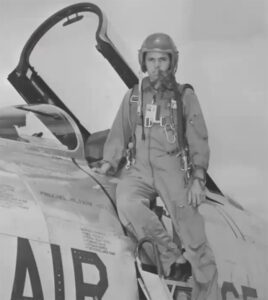
Kirk continued his Air Force career after his release from North Vietnamese captivity. In all, he flew 22 different types of aircraft. Following his Air Force retirement, he had a successful business career.
The Korean War had started, but he was sent to train on the B-25 and B-29 bombers before entering the war. When Kirk arrived in Korea, he served in combat as a forward air controller on an A-T6, marking targets for the fast movers and assessing the damage after missions. He begged for fighters and was transferred to fly F-86 fighter jets. He flew to the Yalu River along the Chinese border but never fired at the enemy.
After returning to the States, he often deployed to Europe, where he flew F-84 and F-100 fighter jets. Over the years, Kirk flew 22 different types of aircraft. His assignments included England Air Force Base, Louisiana; Edwards AFB, California; Myrtle Beach AFB, South Carolina; Japan; and Nellis AFB, Nevada. Kirk wanted to fly in Vietnam and took two weeks’ leave to go to Vietnam, where he flew 25 missions. He knew the base commander and flew up to three times a day.
In January 1967, he volunteered for and received an assignment to fly F-105s, the workhorse dive bomber of the Vietnam War. Kirk commanded the 357th Fighter Squadron in Thailand, flying over North Vietnam. Kirk recalls that there were 19,000 guns within 30 miles of Hanoi, the most heavily defended airspace in the history of air warfare. The Vietnam War was the first combat where SAMs were employed.
Kirk’s POW experiece is not the end of his story. He is, by his own admittance, a type-A personality. While in the military, flying was his total focus. After his time as a POW, he went back to flying and was wing commander of the 29th Flying Training Wing in Selma, Alabama. His last duty assignment was Stuttgart, Germany, where he was vice commander of NATO Special Operations. After retirement, he stayed in Europe and became a financial planner. He was very successful with offices in Italy, including in Sicily. Kirk followed this by becoming an entrepreneur; he opened pizza restaurants in Spain and operated a sailboat charter business. Music continued to be part of his life, and he played in bands and small combos. He married, returned to the U.S., continued financial planning, became a ski instructor, and built 18 houses as an investment in Vail, Colorado.
These days, Kirk is retired in Arizona. He golfs three to four times a week with happy hour on Fridays. He was inducted into the Arizona Military Hall of Fame for civic accomplishments. The nonagenarian Keydet is very proud of the Institute and how VMI prepared him for his military and business careers.
Two things guide Kirk: “Every day above ground is a great day” and “Use every day of your life to learn, work hard, and perform well whatever the situation.”
VMI is proud of this exceptional graduate for his military and business successes.
Editor’s Note: The author, Jim Dittrich ’76, is a retired U.S. Army officer, senior corporate executive, and adjunct professor. He currently serves as the VMI Alumni Association historian. Article sources include online interviews; Veterans History Project, Nov. 29, 2011; Veterans AZ, March 27, 2021; and emails with retired U.S. Air Force Col. Tom Kirk ’50B.
-
Jim Dittrich '76 Alumni Association Historian

